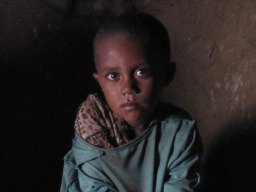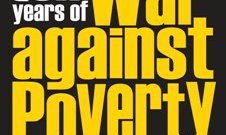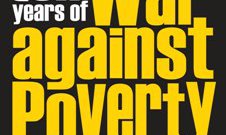
“Along the ancient paths winding up and down the dramatic escarpments we found ourselves briefly intertwined in lives that appear to have changed little over hundreds of years. The track bustled with men and women taking their crops and honey to market, and returning with oil and spices; children on their way to school or taking their family’s livestock onto the hillsides for pasture. We were a day’s walk away from the nearest road, amidst breathtaking mountain scenery. As Zaudito roasted coffee beans over an open fire in the family tukul, her husband Addisu told us that for the first time the village had a small health centre, staffed by two local women who had been trained to provide essential services such as childhood vaccination, hygiene, and birth attendance. Their four children – including their daughter pictured here – will all go to a proper school. Two or three families in the village were benefiting from a scheme to provide incomes to the poorest families, in return for work (such as maintaining the terracing that prevents soil erosion), to keep the poorest families from falling into chronic poverty.”
You can read many anecdotes like this in the annual reports of aid agencies. In fact this happens to be what I saw for myself last weekend in the Amhara region of Northern Ethiopia. All these programmes – health extension workers, free school education, the safety net programme – are managed by the Ethiopian Government, and financed in part by foreign assistance. Addisu supplements his farming income by renting out his donkeys to a community-based tourism scheme managed by a local non governmental organization (NGO). These government and NGO programmes are making a profound difference to the lives of millions of Ethiopians.
If things are so good, why are they so bad?
Almost everyone who has travelled in a developing country has seen aid working. They may have admired the work of an NGO, or seen new schools and clinics. And these individual triumphs add up to impressive statistics. In the last three years the number of people who die from malaria – the cause of one in four deaths in Ethiopia – has been halved by the distribution of nearly twenty million insecticide-treated bed nets and the anti-malarial drugs that are now widely available. It is depressing that 44% of Ethiopians suffer from malnourishment, but it is encouraging to see how much progress has been made: fifteen years ago it was 71% of the population.
In his thought-provoking openDemocracy article, Overseas Development Aid: Is It Working?, Phil Vernon asks whether, if we project ourselves forward twenty-five years, we will pronounce today’s aid policy and practice a success. He is pessimistic:
“Despite billions of dollars being spent on development assistance over the past 60 years, it is doubtful that aid is really working as intended, i.e. providing sufficient impetus to overcome the strong forces that keep people poor.”
If we have all these stories of aid making a positive difference why does Phil – along with many others – think that aid does not work?
Like everything in development this predicament has its own piece of impenetrable jargon: it is called the “micro-macro paradox”. Zambian economist Dambisa Moyo reckons that the answer is clear: not only does aid not work, it makes matters worse in developing countries (Dead Aid, 2009). In his article on this site (Aid pessimism: myth and reality), Robert Picciotto is equally decided in the opposite direction. Using taxes for aid, he says, saves more lives than using taxes for any other purpose. Although at first glance these views seem contradictory, we can in fact reconcile them.
What is aid for?
At the heart of the apparent paradox is a concealed diversity of opinion about what aid should be trying to achieve.
When we say that we have seen aid work in practice, we mean that children now have access to basic health care. We mean that money has been invested in roads and infrastructure that make markets work better. We mean that children go to school where they learn to read and write, and that the poorest families are protected from hunger and chronic poverty. We mean that women no longer have to spend several hours a day fetching water or firewood.
But we also have bigger aspirations for what aid can achieve. Phil Vernon says:
“the purpose is … to help transform the contexts and conditions which define poor people’s opportunities and choices, so that they stop being poor … it follows that aid institutions should be designed for and evaluated against an ability to promote transformation … they need to be set up in a way that supports locally tailored approaches and promotes the fundamentally societal and political changes which are needed.” [emphasis as in original]
Everyone likes the idea of permanent social and political transformation. Citizens of developing countries do not want to live on hand-outs any more than you or me: they want economic security through a job and the ability to participate in a well-functioning economy. No developing country wants to be dependant on aid, with the attendant costs to its international status and national sovereignty. Politicians in donor countries defend aid on the basis that it is a purely temporary measure. We all want developing countries to be able to do without aid in the future.
Although economic and political change is indeed important and desirable, it doesn’t follow that aid is an especially good way to bring it about. Processes of social, political, economic and institutional development have an internal dynamic which cannot easily be influenced by money from outside.
In principle, though, aid can be used in ways that make such transformations more likely. It can pay for critical infrastructure – such as power, roads and ports – on which economic growth depends. It can finance new skills and capacity. It can provide access to financial services for entrepreneurs wanting to build their businesses. It is also reasonable to think that investments in health and education will, in the long run, support more rapid economic growth. Some of the most striking examples of growth in the 20th century were in countries such as Korea and Taiwan, which were supported by large amounts of aid. Aid was one of the combination of factors which led to rapid growth in Botswana after independence (progress which has recently and tragically been undermined by the HIV epidemic). But while aid may help to make this kind of economic and social transformation more likely, it is unlikely to be its main cause; and there are many examples of countries which have received a lot of aid but which have not yet experienced rapid economic growth. In the pursuit of economic growth, aid might be like venture capital: many investments will not succeed, but the few that do will yield huge pay-offs. What is more, even though faster economic growth is not always achieved, aid can make a huge difference to the quality of people’s lives in the meantime.
Rich countries can do much more than give aid to help countries along the bumpy road of social and economic change. They can open their markets to trade, tackle corruption, make resource flows more transparent, limit climate change, tackle the causes of conflict, control the sales of small arms, share technologies, liberalise migration policies, and work together to fight global health problems. They can also use political measures – such as travel bans or embargoes – to put pressure on governments to change. These kinds of policy changes are likely to play a much bigger role than aid in creating the conditions for change. When rich countries fail to make progress on these issues they too often use aid as a fig-leaf to cover their embarrassment.
So the apparent paradox of individual success of aid programmes but slow progress in development is partly explained by the expectation that aid will achieve multiple objectives. There is no contradiction when Robert Picciotto says that aid is one of the most cost effective ways of saving lives, and Phil Vernon says it has not been very successful at transforming societies. It is logically possible that both are right. Furthermore, as we shall see, even if there is a link between aid and a nation’s economic growth, that may be much harder to demonstrate than the more easily measurable direct benefits of aid on individual people’s lives.
Does aid lead to economic growth?
An alternative explanation of the paradox is that aid could – at least in principle – have positive benefits for a particular group and yet have a negative impact on society as a whole. For example, aid might successfully provide education or health care but simultaneously harm long-term prospects for overall growth by corroding the accountability of domestic institutions or by damaging a nation’s competitiveness.
Although it is theoretically possible that aid could be doing more harm than good, in practice there is no evidence at all that this is happening. It is intellectually lazy to side-step proper analysis by observing that many developing countries remain poor despite having received billions of dollars of aid over many decades. That does not tell us whether aid to those countries has made matters better or worse than would have been the case without it. Britain spends about one hundred times as much on health care each year as it does on aid to Africa, but people in Britain still get sick. Does that mean that health spending doesn’t work? Perhaps doctors are actually making us ill? More likely, we would have even bigger health problems without all that spending.
These big-picture effects of aid are fiendishly difficult to measure. To understand the overall impact of aid we need to compare today’s world with an alternative universe where there is no aid. But econometricians are not magicians and there is no way to measure what would have happened without aid. If it does make a difference to economic growth, aid is likely to be one among many other determinants, and our statistical tools are not powerful enough to separate the precise contribution of aid. If improvements in health and education do feed through into higher growth – as common sense tells us they might – the effects are likely to take many years to materialize, making it very difficult to measure any statistical relationship. As far as I know no reputable econometrician has ever found that aid has a negative impact on growth overall, although some have found that aid has had little impact either way. The safest conclusion is that statistical comparisons of growth rates of different countries do not enable us to say anything either way about the effect of aid.
We should also bear in mind that very little aid has so far been given to people in the poorest countries. It is sometimes observed that roughly $500 billion has been given to sub-Saharan Africa since independence and that sounds like a lot of money. But actually it isn’t very much: over the last twenty years aid per person in sub-Saharan Africa has averaged 41 cents a week. Does the continued existence of poverty prove that Africans have squandered the 41 cents a week that we have so generously provided for their well-being and self-improvement? (The British people may be thankful that the United States Marshall Plan after the Second World War provided ten times this amount per person.) The economist Jeff Sachs compares the current situation in Africa to a forest fire: if we try to put out the fire with one hose, and the fire continues to rage, do we conclude that fighting fires is hopeless? Do we conclude that water is not effective at putting out fires? Or do we conclude that we have not yet applied enough water and that we do not have enough firefighters and hoses?
Aid works but it could work better
Aid is a precious resource which saves millions of lives every year and improves the quality of life for many more. We have a duty to make it work as well as we can. There is broad agreement on both the need to make aid more effective, and the central components of how that can be done. Aid should be: better targeted on the poorest; used to support home-grown priorities, local systems and institutions; more predictable and longer-term; more efficiently provided with less bureaucracy and fewer overheads; and more ruthless about scaling up good programmes and cutting out bad ones.
Many lives would be saved, and many more improved, if these problems were addressed, and yet reform of the aid system is glacially slow. The present aid system is the product of decades of compromise: it has settled into an equilibrium which only partly serves the interests of both donors and developing country governments, and which is very likely not the best way to serve the interests of the poor. We cannot change the equilibrium merely by announcing good intentions: we have to change the political and institutional incentives which have got us where we are.
The best prospects for reforming aid are to make it more transparent and competitive, and more accountable to the people it is intended to serve. Costs and inefficiencies will be squeezed out of the system not by central decree but by stronger bottom-up pressures to improve. Innovation, variation and selection underpin evolution. For aid, that means promoting more effective feedback from the intended beneficiaries of aid (and not only from their governments), creating greater competition among aid suppliers, implementing more rigorous and credible measurement of results, crafting disincentives to anti-social behaviour (such as taxes on proliferation), and providing funding which is more closely aligned with results.
A modest proposal
Now back in Addis Ababa, I look out of my window and watch children coming out of school. Although these girls and boys will never meet the people who paid for part of their education – the millions of men and women who contribute to aid through their taxes and in many cases through donations to charity – they are making the most of an opportunity to go to school that their parents never had. Seeing these children with their exercise books under their arms is enough to convince me that aid works – at least in the sense that it changes people’s lives for the better – irrespective of whether we can demonstrate a statistical link with economic growth.
Long-lasting social, political and economic change in developing countries is a laudable goal. There is a lot that industrialised countries can and should do to create conditions in which these changes are more likely to start and to succeed, especially by adjusting their own policies on issues such as trade, corruption, migration, peace and security, intellectual property and climate change.
Aid alone is unlikely to transform societies, although it can help to sustain and accelerate change by paying for critical infrastructure, security and better government, all things which make it likelier that a country will make faster progress towards economic growth and accountable institutions. Where the conditions for transformation do come together, it would be a colossal wasted opportunity if the process were to falter or fail for lack of resources.
Irrespective of whether it sometimes contributes to social and economic transformation, aid can and does transform people’s lives. Aid improves access to health, education, clean water and sanitation. It gives people access to small loans that they can take out for their business or to get through lean times. It feeds people when they are hungry, and provides a safety net to prevent them falling into chronic poverty.
And these improvements in people’s lives are not rare or random exceptions. Charles Kenny points out that on almost any measure of the quality of life other than income there has been rapid and ubiquitous global improvement. For example, in the last fifty years global infant mortality has more than halved. Without this improvement in health, nine million children – almost all of them in developing countries – would not have celebrated their first birthday this year.
So perhaps the reputation of aid is a victim of the aspirations of its supporters. To justify the aid budget, we have made extravagant claims about what it will achieve. Not content with making an extraordinary difference in people’s lives – a difference which more than justifies the very small cost of aid – we have sold aid as a tool to transform institutions and societies. But the cases in which aid can do this may be few and far between, and even in those cases it is very difficult to demonstrate the contribution that aid has made. By making excessive claims for what aid can achieve, we may have opened the door for critics to say that it is not working.
There is no question that aid enables people to live better lives while wider social and economic changes are taking place. While you are reading this sentence, somewhere in the developing world a mother is holding in her arms her child who is dying from an easily preventable or treatable disease. If we gave more and better aid, fewer children like this would die. To my mind, that is reason enough to give aid.
I wish you could hear, as I can right now, the sound of Ethiopian children laughing as they come out of school. Because that’s how I know that aid works.
Read more
Get our weekly email





Comments
We encourage anyone to comment, please consult the oD commenting guidelines if you have any questions.